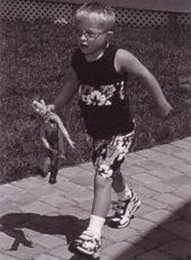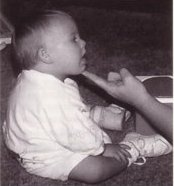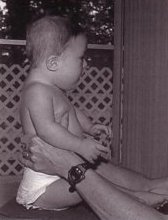The Goal and Opportunity of Physical Therapy for Children with Down Syndrome
By Patricia C. Winders, PT
Not reprintable without the author's permission.

Summary: The appropriate goal of physical therapy for children with Down syndrome (DS) is not to accelerate their rate of gross motor development as is commonly assumed. The goal is to minimize the development of abnormal compensatory movement patterns that children with DS are prone to develop. Early physical therapy makes a decisive difference in the long-term functional outcome of the child with DS. Beyond this goal, there is an additional opportunity that physical therapy makes available to parents. Because gross motor development is the first learning task that the child with DS encounters, it provides parents with the first opportunity to explore how their child learns. There is increasing evidence that that children with DS have a unique learning style. Understanding how children with Down syndrome learn is crucial for parents who wish to facilitate the development of gross motor skills as well as facilitating success in other areas of life including language, education and the development of social skills.
The Goal of Physical Therapy
Before discussing what the goal of physical therapy for children with DS is, it is necessary first to understand what the goal is not. The goal of physical therapy is not to accelerate the rate of gross motor development. This statement is more controversial than it may initially seem to be. Many parents, many physical therapists and many insurance companies assume that the value of physical therapy can be measured by whether or not a child is achieving motor skills more quickly. Some therapeutic techniques promote themselves by saying that children who are treated with that technique develop motor skills earlier. If, however, one begins with the premise that the goal of physical therapy is to accelerate the rate of gross motor development, then one needs to answer the question posed by that mother. What difference will it make in 9 or 10 years that a child with DS walked at 21 months rather than 24 months of age? How will that three-month difference affect a child's long-term functional outcome? I do not believe that it will make any difference whatsoever, and therefore, I do not believe that it is the appropriate goal for physical therapy for children with DS. The rate of gross motor development in children with DS is influenced by a number of factors, including hypotonia, ligamentous laxity, decreased strength and short arms and legs. These factors are determined by genetics, and although some may be influenced by physical therapy, they cannot be fundamentally altered.So them what is the goal of physical therapy for children with DS? Children with DS attempt to compensate for their hypotonia, ligamentous laxity, decreased strength and short limbs by developing compensatory movement patterns which, if allowed to persist, often develop into orthopedic and functional problems. The goal of physical therapy is to minimize the development of the compensatory movement patterns that children with DS are prone to develop.
Gait is a primary example. Ligamentous laxity, hypotonia and weakness in the legs lead to lower extremity posturing with hip abduction and external rotation, hyperextension of the knees and pronation and eversion of the feet. (See figure 1.) Children with DS typically learn to walk with their feet wide apart, their knees stiff and their feet turned out. They do so because hypotonia, ligamentous laxity and weakness make their legs less stable. Locking their knees, widening their base and rotating their feet outward are all strategies to increase stability. The problem is, however, that this is an inefficient gait pattern for walking. The weight is being borne on the medial (inside) borders of the feet, and the feet are designed to have the weight borne on the outside borders. If this pattern is allowed to continue, problems will develop with both the knees and the feet. Walking will become painful, and endurance will be decreased. Physical therapy should begin teaching the child with DS the proper standing posture (i.e., feet positioned under the hips and pointing straight ahead with a slight bend in the knees) when he or she is still very young. (See figure 2.) With appropriate physical therapy, gait problems can be minimized or avoided. (See figure 3.)
 |
 |
 |
| Figure 1 | Figure 2 | Figure 3 |
Trunk position is another example. Ligamentous laxity, hypotonia and decreased strength in the trunk encourage the development of kyphosis, which is often first seen when the child is learning to sit. Children with DS typically learn to sit with a posterior pelvic tilt, trunk rounded and the head resting back on the shoulders. (See figure 4.) They never learn to actively move their pelvis into a vertical (upright) position, and therefore, cannot hold their head and trunk over it. If this posture is allowed to persist, it will ultimately result in impaired breathing and a decreased ability to rotate the trunk. Physical therapy must teach the child the proper sitting posture by providing support at the proper level even before the child is able to sit independently. (See figure 5.) First, the therapist provides upper trunk support, then middle trunk support, then support between the scapula and the waist, then support at the waist and finally pelvic support. The support provided at each level keeps the spine and pelvis in proper alignment until the child develops the strength to hold that segment in alignment himself. Appropriate physical therapy can minimize problems with trunk posture. (See figure 6.)
 |
 |
 |
| Figure 4 | Figure 5 | Figure 6 |
Physical therapy services:
- should be concerned with the child's long-term functional outcome;
- should seek to minimize the development of compensatory movement patterns;
- should be based on a thorough understanding of the compensatory movement patterns that children with DS are prone to developing;
- should be strategically designed to proactively build strength in the appropriate muscle groups so that the child with DS develop optimal movement patterns;
- should focus on gait, posture and exercise.
The Opportunity of Physical Therapy
If physical therapy has achieved the goal of minimizing the development of abnormal movement patterns, it will have influenced the health of the child with DS throughout the course of his or her life. But there is actually an opportunity beyond the development of motor skills of which parents may wish to take advantage while their child is receiving physical therapy.There is mounting evidence that children with DS do not learn in the same manner that typical children do. They have a different style of assimilating information, and therefore, the usual methods of instruction are less effective. The development of gross motor skills is the first learning task that the child with DS and his parents face together. There are many other challenges to come including language, education, and the development of social skills, but learning gross motor skills is the first developmental challenge. The opportunity is for parents to use the arena of gross motor development to begin to understand how their child learns. Knowing how to facilitate their child's learning will be critical to their success in collaborating with their child throughout his or her lifetime.
Wishart (1991),a psychologist at the University of Edinburgh in Scotland, has done leading edge work in studying how children with DS learn. She writes:
Despite the absence of an adequate developmental database, theory and practice in this area have nonetheless continued to assume that the process of learning in children with DS is essentially a slowed-down version of normal cognitive development. An increasing number of recent studies are suggesting that this 'slow development' approach may be ill founded and that learning may differe significantly in structure and organization from that found in ordinary children...Investigation into the learning style of children with DS is in its early stages. Kumin and Oelwein also have made important contributions in this area. In her book Classroom Language Skills for Children with Down Syndrome: A Guide for Parents and Teachers (2001), Kumin discusses how the insights of Howard Gardner can be applied to children with DS. Gardner's book, Frames of Mind (1983), presents the theory of multiple intelligences, which postulates that intelligence is multi-faceted. The theory holds that besides linguistic and mathematical intelligences, there are also spatial, interpersonal and musical intelligences, to mention only a few. Kumin notes that it has been her experience that many children with DS learn well using music. She has also written about the unique learning style of children with DS and how it pertains to learning speech and language.
Infants with DS consistently showed evidence of underperforming, with avoidance routines being produced on many of the tasks presented, regardless of whether these were above or below the infant's current developmental level. New skills, even once mastered, proved to be inadequately consolidate, often disappearing from the infant's repetoire in subseequent months. Follow-up studies using a wider range of tasks proved additional evidence of this tendency to 'switch out' of cognitive tasks, with many children failing on items which should have been within their capabilities and which had ben passed in earlier sessions...
Regardless of whether these irregular performance profiles reflect genuine developmental instability or are the result of fluctuating motivation in assessment-type situations, it remains that if test behaviour is typical of behaviour in other, everyday situations, development itself must be compromised.
Oelwin also has written about the learning style of children with DS and how it impacts education. She has highlighted the need to consciously assist children with DS with how information can be effectively filed, stored and retrieved. Her book, Teaching Reading to Children with Down Syndrome: A Guide for Parents and Teachers (1995), provides a step-by-step guide to teaching reading to children with DS. All of this work point to how important it is for parents to have an understanding of how their child assimilates information so that they can be successful partners in their child's learning.
It has been my experience in 21 years of providing physical therapy to children with DS that they do indeed learn differently and that it is necessary to modify my approach if I wish to obtain the best result. I consider it an important opportunity of my work to help parents begin to understand how their child learns. The following "tips" were derived from many years of working with children with DS. They are offered as a starting point for both parents and therapists to begin to explore the unique learning style of the child with DS.
- Children with DS have a decreased ability to generalize. This means that a skill learned in one setting does not necessarily transfer to another setting. For instance, a child may be quite competent climbing the stairs at home, but when confronted with stairs elsewhere, he or she may regress to a more primitive stair-climbing strategy until he or she has relearned the skill in the new setting.
- Children with DS need information to be delivered in small bite-sized pieces. It has been my experience that if a child appears to have plateaued, the problem is most likely to be that the next piece of information is too large and needs to be further broken down.
- The setup is crucial and needs to be as close to perfect as possible. Children with DS need structure, consistency and a familiar environment if you hope to get their best performance. Do not try something new or challenging when the child is tired, hungry or not at his best for some reason. The quality of the work you do together is more important than the quantity. Minimize distractions for the environment.
- Follow the child's lead. The child must be motivated to perform a particular skill. Trying to impose your will on a child with DS is a losing game. I often try to model my style of interaction after the parents' style. It is familiar to the child and most likely to be successful.
- Be attentive to how the child reacts when learning new gross motor skills. Some children are cautious and others are risky. A cautious child prefers to stay in one position, while the risky child prefers to be in motion. For example, when learning to walk, the cautious child will want lots of support and will be upset if he or she falls. The risky child will like walking because it involves movement and will not be concerned about support or care how many times he or she falls.
- Know when to quit. Some children will only give you two repetitions at a particular skill and then insist on moving on. Other children will gladly give you a dozen repetitions. Set up the game so that the child is successful and avoid frustration.
- Be strategic in planning your session. Practice what the child is ready to learn. Tackle the most difficult skills first before the child becomes tired. Alternate difficult skills with easier ones to give the child time to recover his strength.
- Be strategic in providing support. Children with DS tend to become quickly dependent on support. Provide as little support as possible while still allowing the child to succeed and remove the support as soon as possible.
- Skills will be learned grossly at first and then refined. For instance, children will initially learn to walk with a wide base and their feet externally rotated. This is not the optimal gait pattern, but it needs to be allowed initially and then refined trough the post-walking skills.
- Do not interfere with an established skill in which the child has achieved independence. You will not be successful in introducing change and the child will only experience you as nagging. Change will need to be made at the next level of motor development. For instance, some children, instead of learning to creep on both knees, learn to creep on one knee and one foot. Once this pattern has been established and the child is proficient in its use, you will not be successful in altering it and will succeed only in angering the child. Teach the child to use both knees in climbing up stairs rather than interfering with the established pattern.
- Children with DS learn best through a gradual process:
- Introduction of the new skill is the first step. The new skill needs to be introduced slowly and carefully with the goal being simply to have the child tolerate the movement.
- Familiarity is the second step. In this step, the child becomes accustomed to the skill and how it feels physically. This is the "I get it" phase in which the child understands the game and what is being asked of him or her.
- Collaboration is the third step. The child increase his collaboration and cooperation, and at the same time support is decreased.
- Independence is the final step where the child has mastered the skill and can perform it independently without support.
Parents who are newly assuming the responsibility of caring for a child with DS are confronted with a confusing array of treatment options and opportunities. It can be difficult to know where to focus limited time and resources. It is hoped this article will provide parents and caregivers with a starting point and a framework for making decisions about what is important. They should think about proposed therapies just like the mother described in the first paragraph, from the perspective of the child's long-term functional outcome. Let the long-term functional outcome guide decisions about what to work on, and let the understanding of the child's learning style guide decisions about how to work on them.
References
- Gardner, H (1983). Frames of Mind: the Theory of Multiple Intelligences.Basic Books.
- Kumin, L (2001). Classroom Language Skills for Children with Down Syndrome: A Guide for Parents and Teachers. Woodbine House.
- Oelwin, P (1995). Teaching Reading to Children with Down Syndrome: A Guide for Parents and Teachers. Woodbine House.
- Winders, P (1997). Gross Motor Skills in Children with Down Syndrome: A Guide for Parents and Professionals. Woodbine House.
- Wishart, JG (1995). Cognitive Abilities in Children with Down Syndrome. In: CJ Epstein, T Hassold, I Lott, L Nadel & D Patterson (eds.) Etiology and Pathogenesis of Down Syndrome. Wiley-Liss Inc.
- Wishart, JG (1991). Taking the initiative in learning: a developmental investigation of children with Down syndrome. International Journal of Disability, Development and Education, 38, 27-44.